The Timing of Water and Beverage Consumption During the Day Among Children and Adults in the United States: Analyses of NHANES 2011–2016 Data
Abstract
:1. Introduction
2. Materials and Methods
2.1. Dietary Intake Databases
2.2. Participant Characteristics
2.3. Water and Beverage Categories
2.4. Water and Beverages by Meal Type and Time of Day
2.5. Data Availability and Ethical Approval
2.6. Statistical Analyses
3. Results
3.1. Total Water Intakes from Water and Beverages
3.2. Water and Beverage Consumption by Time of Day
3.3. Water and Beverage Consumption by Age Group and Time of Day
4. Discussion
5. Conclusions
Supplementary Materials
Author Contributions
Funding
Conflicts of Interest
References
- Dietary Guidelines for Americans; U.S. Department of Health and Human Services and U.S. Department of Agriculture: Washington, DC, USA, 2015.
- Popkin, B.M.; Armstrong, L.E.; Bray, G.M.; Caballero, B.; Frei, B.; Willett, W.C. A new proposed guidance system for beverage consumption in the United States. Am. J. Clin. Nutr. 2006, 83, 529–542. [Google Scholar] [CrossRef] [PubMed]
- Vieux, F.; Maillot, M.; Rehm, C.; Barrios, P.; Drewnowski, A. Tap and bottled water consumption patterns among children and adults in the United States: Analyses of NHANES 2011–16 data. Nutr. J. 2019. (under review). [Google Scholar]
- Drewnowski, A.; Rehm, C.D.; Constant, F. Water and beverage consumption among children age 4-13y in the United States: Analyses of 2005–2010 NHANES data. Nutr. J. 2013, 12, 85. [Google Scholar] [CrossRef] [PubMed]
- Drewnowski, A.; Rehm, C.D.; Constant, F. Water and beverage consumption among adults in the United States: Cross-sectional study using data from NHANES 2005–2010. BMC Public Health 2013, 13, 1068. [Google Scholar] [CrossRef] [PubMed]
- Duffey, K.J.; Poti, J. Modeling the effect of replacing sugar-sweetened beverage consumption with water on energy intake, HBI score, and obesity prevalence. Nutrients 2016, 8, 395. [Google Scholar] [CrossRef] [PubMed]
- Pieper, K.J.; Katner, A.; Kriss, R.; Tang, M.; Edwards, M.A. Understanding lead in water and avoidance strategies: A United States perspective for informed decision-making. J. Water Health 2019, 17, 540–555. [Google Scholar] [CrossRef] [PubMed]
- Ruckart, P.Z.; Ettinger, A.S.; Hanna-Attisha, M.; Jones, N.; Davis, S.I.; Breysse, P.N. The Flint Water Crisis: A Coordinated Public Health Emergency Response and Recovery Initiative. J. Public Health Manag. Pract. 2019, 25, S84–S90. [Google Scholar] [CrossRef] [PubMed]
- Laguna, M.C.; Hecht, A.A.; Ponce, J.; Jue, T.; Brindis, C.D.; Patel, A.I. Teachers as Healthy Beverage Role Models: Relationship of Student and Teacher Beverage Choices in Elementary Schools. J. Community Health 2019, 1–7. [Google Scholar] [CrossRef] [PubMed]
- Schatzer, M.; Schätzer, J.; Hoppichler, F. School Programs in Austria: A Combined Behavioral and Environmental Intervention to Promote Healthy Hydration. Ann. Nutr. Metab. 2019, 74, 25–29. [Google Scholar] [CrossRef] [PubMed]
- Vieux, F.; Maillot, M.; Constant, F.; Drewnowski, A. Water and beverage consumption patterns among 4 to 13-year-old children in the United Kingdom. BMC Public Health 2017, 17, 479. [Google Scholar] [CrossRef] [PubMed]
- Vieux, F.; Maillot, M.; Constant, F.; Drewnowski, A. Water and beverage consumption among children aged 4-13 years in France: Analyses of INCA 2 (Étude Individuelle Nationale des Consommations Alimentaires 2006-2007) data. Public Health Nutr. 2016, 19, 2305–2314. [Google Scholar] [CrossRef]
- Drinking Water at the Correct Time. Available online: https://health.trythis.co/drink-water-drinking-water-correct-time/%0D (accessed on 9 October 2019).
- Bailey, C. Killer Morning Habit: Drink 16oz of Water, Right After You Wake Up. Available online: https://alifeofproductivity.com/killer-morning-habit-drink-water-right-after-you-wake-up/ (accessed on 9 October 2019).
- Are You Drinking Water at the Right Times of Day? Available online: https://camillestyles.com/wellness/drinking-water-at-the-right-times-of-day/ (accessed on 9 October 2019).
- Athanasatou, A.; Kandyliari, A.; Malisova, O.; Kapsokefalou, M. Fluctuation of water intake and of hydration indices during the day in a sample of healthy Greek adults. Nutrients 2019, 11, 793. [Google Scholar] [CrossRef]
- Centers for Disease Control and Prevention. National Center for Health Statistics (NHANES)—About the National Health and Nutrition Examination Survey. Available online: https://www.cdc.gov/nchs/nhanes/about_nhanes.htm (accessed on 9 October 2019).
- Centers for Disease Control and Prevention. National Health and Nutrition Examination Survey Questionnaire: Dietary Interview Component. Available online: https://www.cdc.gov/nchs/data/nhanes/nhanes_11_12/dietary_post_recall_qs_2011.pdf (accessed on 9 October 2019).
- Centers for Disease Control and Prevention National Health and Nutrition Examination Survey Questionnaire: Phone Follow-Up Dietary Interviewer Procedures Manual. Available online: https://wwwn.cdc.gov/nchs/data/nhanes/2009-2010/manuals/phone_follow_up_dietary_procedures_manual_mar_2010.pdf (accessed on 9 October 2019).
- USDA Food and Nutrient Database for Dietary Studies 2015–2016; U.S. Department of Agriculture, Agricultural Research Service: Beltsville, MD, USA, 2019.
- Centers for Disease Control and Prevention. NHANES—NCHS Research Ethics Review Board Approval. Available online: https://www.cdc.gov/nchs/nhanes/irba98.htm%0D (accessed on 9 October 2019).
- Martyn, D.; Lau, A.; Richardson, P.; Roberts, A. Temporal patterns of caffeine intake in the United States. Food Chem. Toxicol. 2018, 111, 71–83. [Google Scholar] [CrossRef]
- Panahi, S.; El Khoury, D.; Luhovyy, B.L.; Goff, H.D.; Anderson, G.H. Caloric beverages consumed freely at meal-time add calories to an ad libitum meal. Appetite 2013, 65, 75–82. [Google Scholar] [CrossRef] [PubMed]
- Panahi, S.; Luhovyy, B.L.; Liu, T.T.; Akhavan, T.; El Khoury, D.; Goff, H.D.; Harvey Anderson, G. Energy and macronutrient content of familiar beverages interact with pre-meal intervals to determine later food intake, appetite and glycemic response in young adults. Appetite 2013, 60, 154–161. [Google Scholar] [CrossRef] [PubMed]
- Almiron-Roig, E.; Palla, L.; Guest, K.; Ricchiuti, C.; Vint, N.; Jebb, S.A.; Drewnowski, A. Factors that determine energy compensation: A Systematic review of preload studies. Nutr. Rev. 2013, 71, 458–473. [Google Scholar] [CrossRef] [PubMed]
- Bray, G.A.; Popkin, B.M. Calorie-sweetened beverages and fructose: What have we learned 10 years later. Pediatr. Obes. 2013, 8, 242–248. [Google Scholar] [CrossRef] [PubMed]
- Increasing Access to Drinking Water in Schools; Centers for Disease Control and Prevention: Atlanta, GA, USA, 2014.
- Patel, A.I.; Schmidt, L.A.; Lee, P.R. Water access in the United States: Health disparities abound & solutions are urgently needed. Am. J. Public Health 2017, 107, 1354–1356. [Google Scholar] [PubMed]
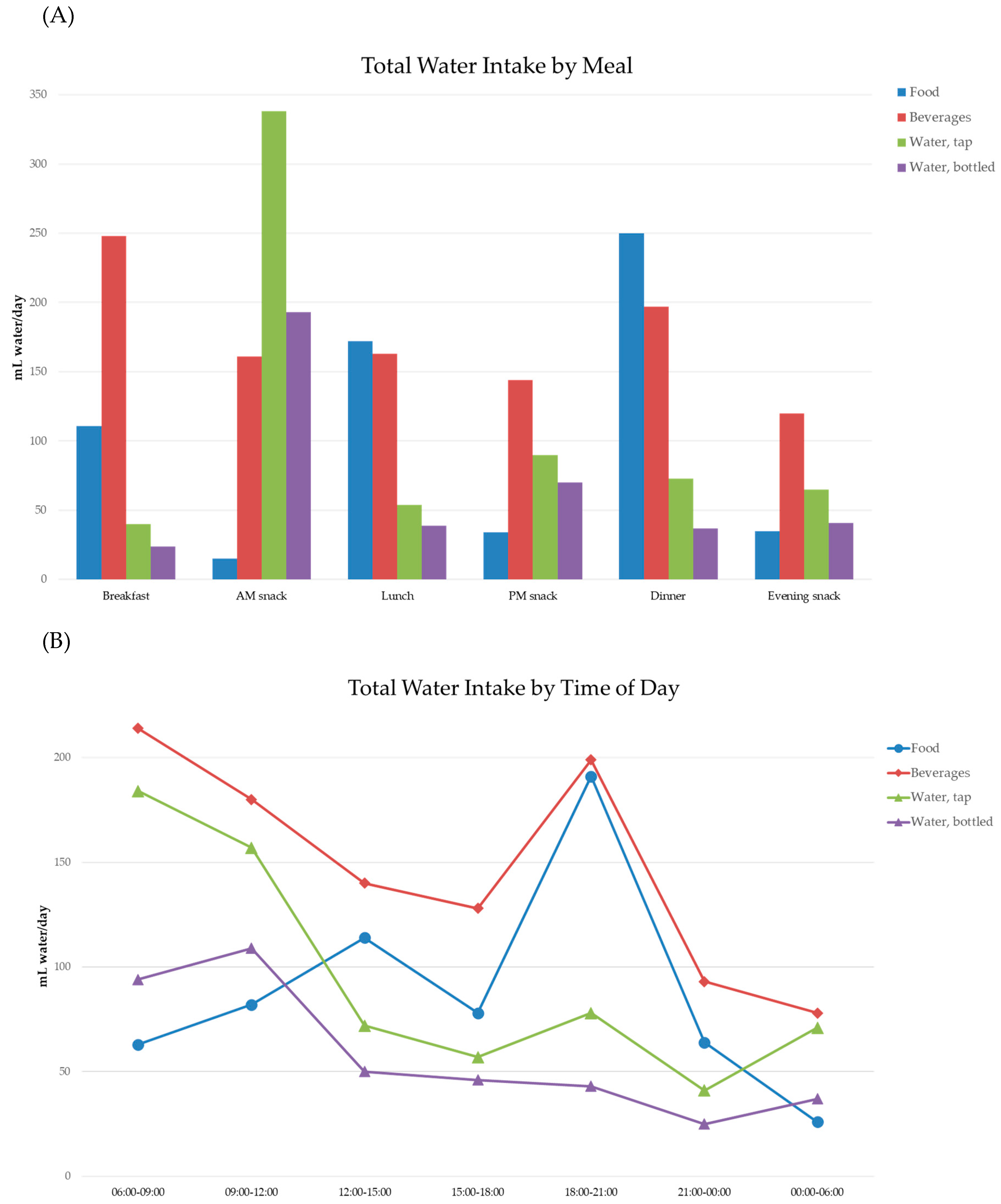
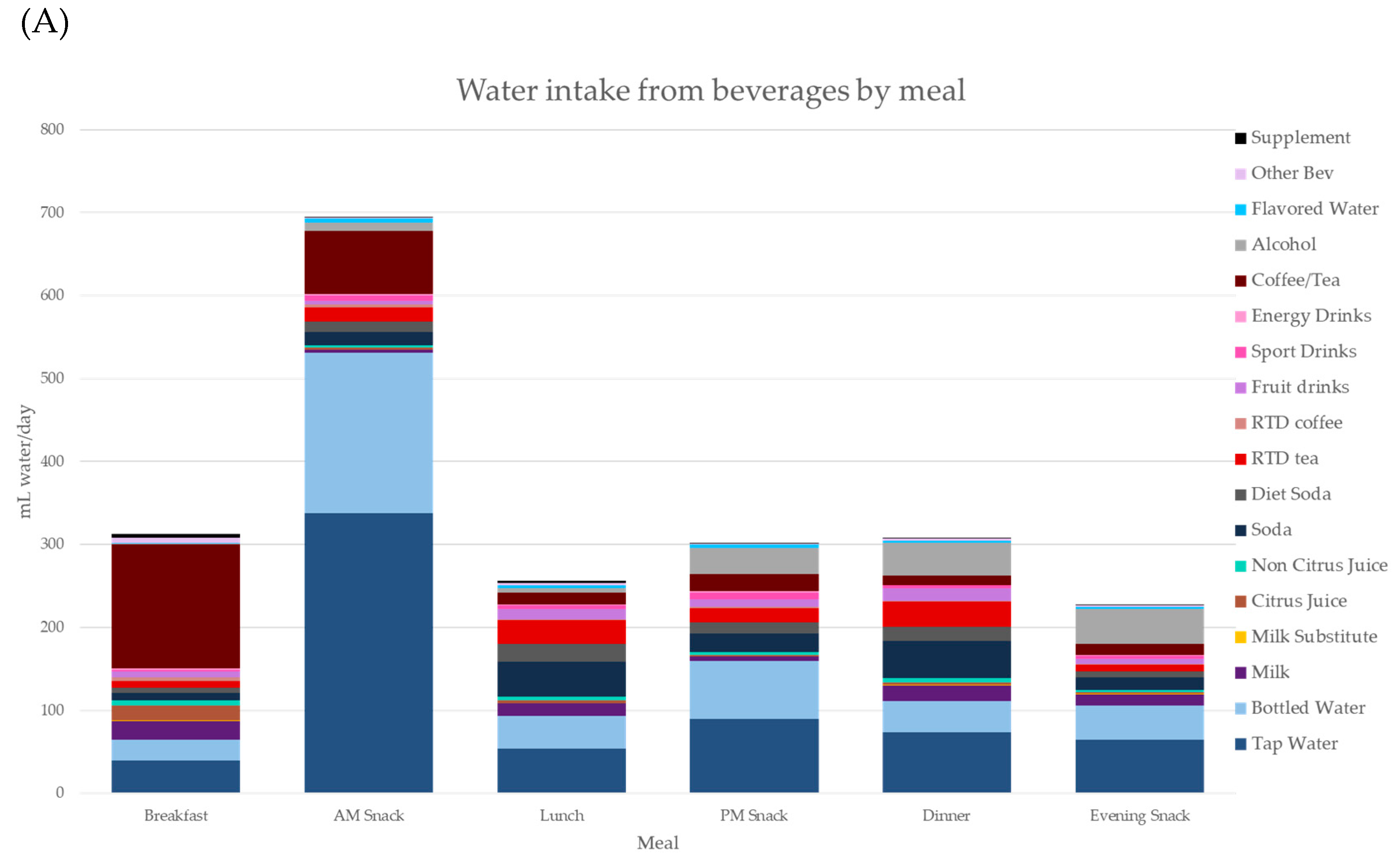
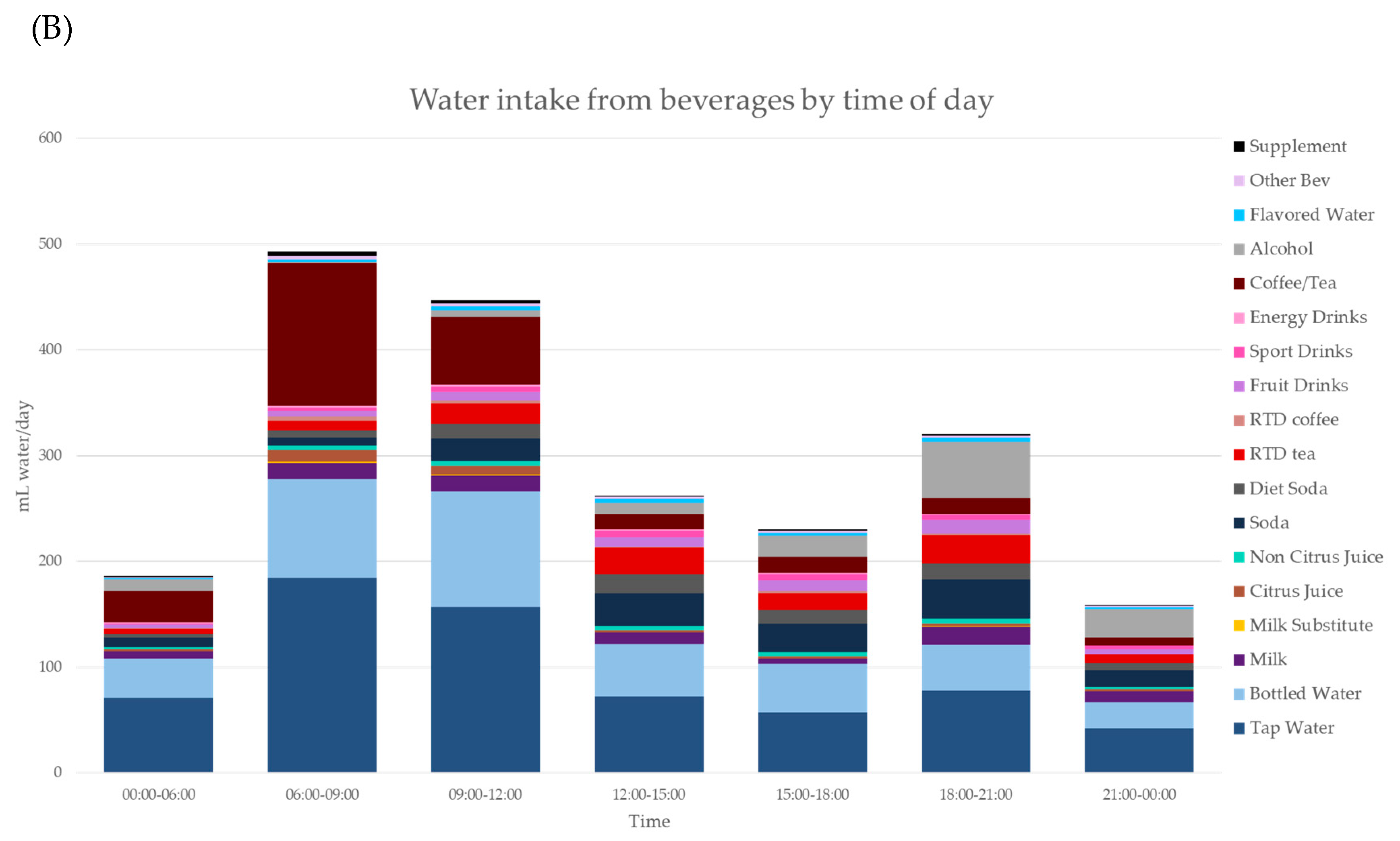
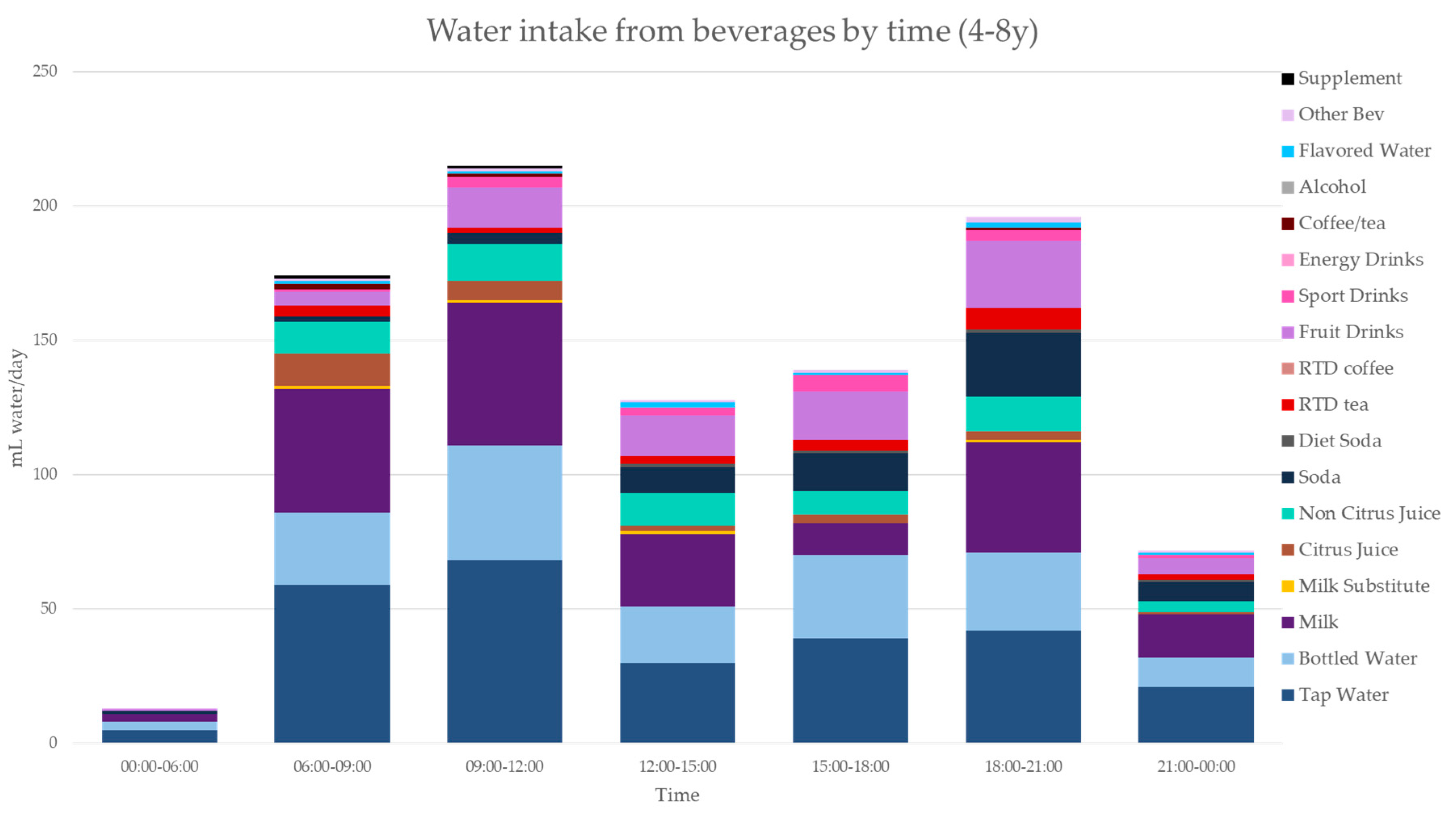
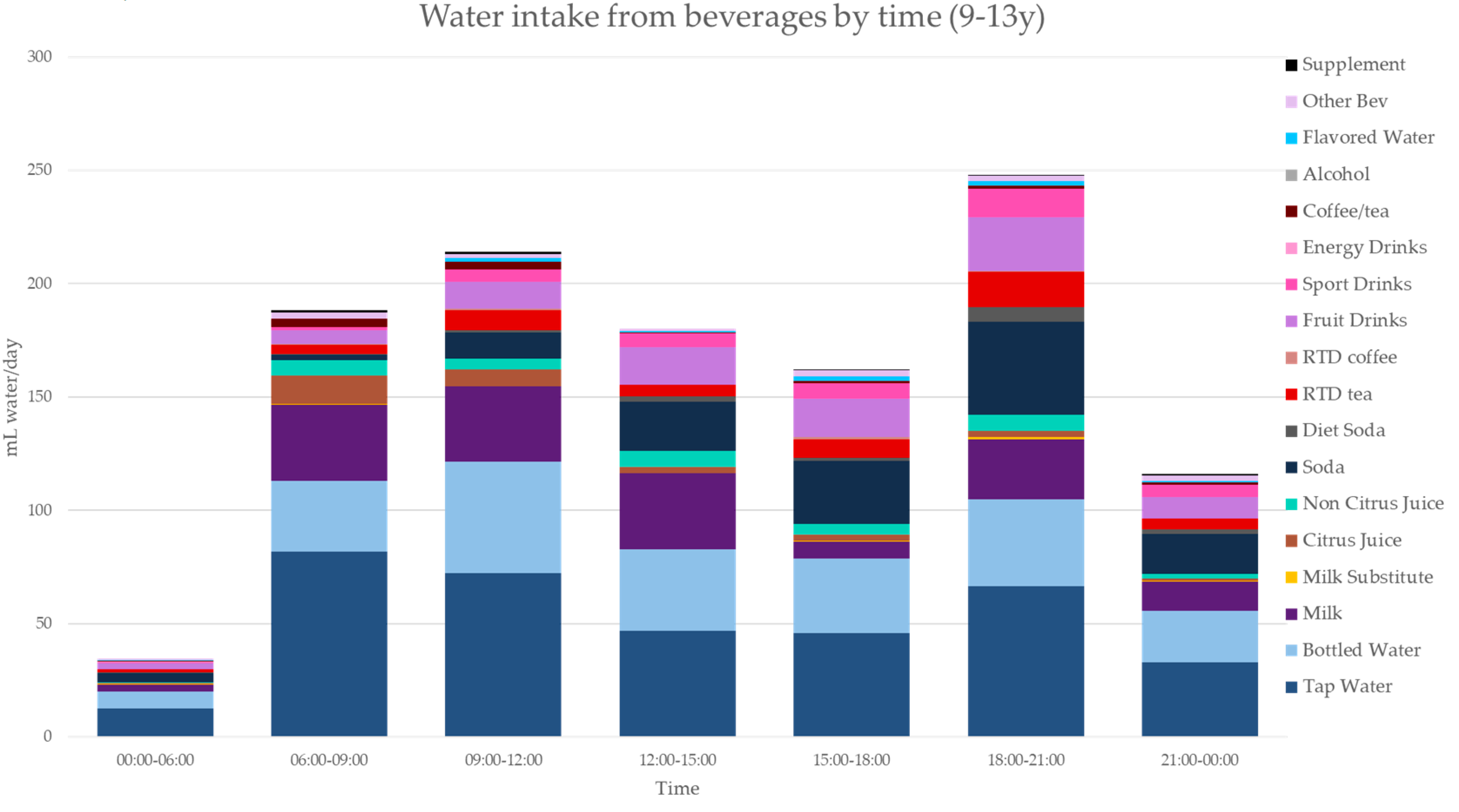
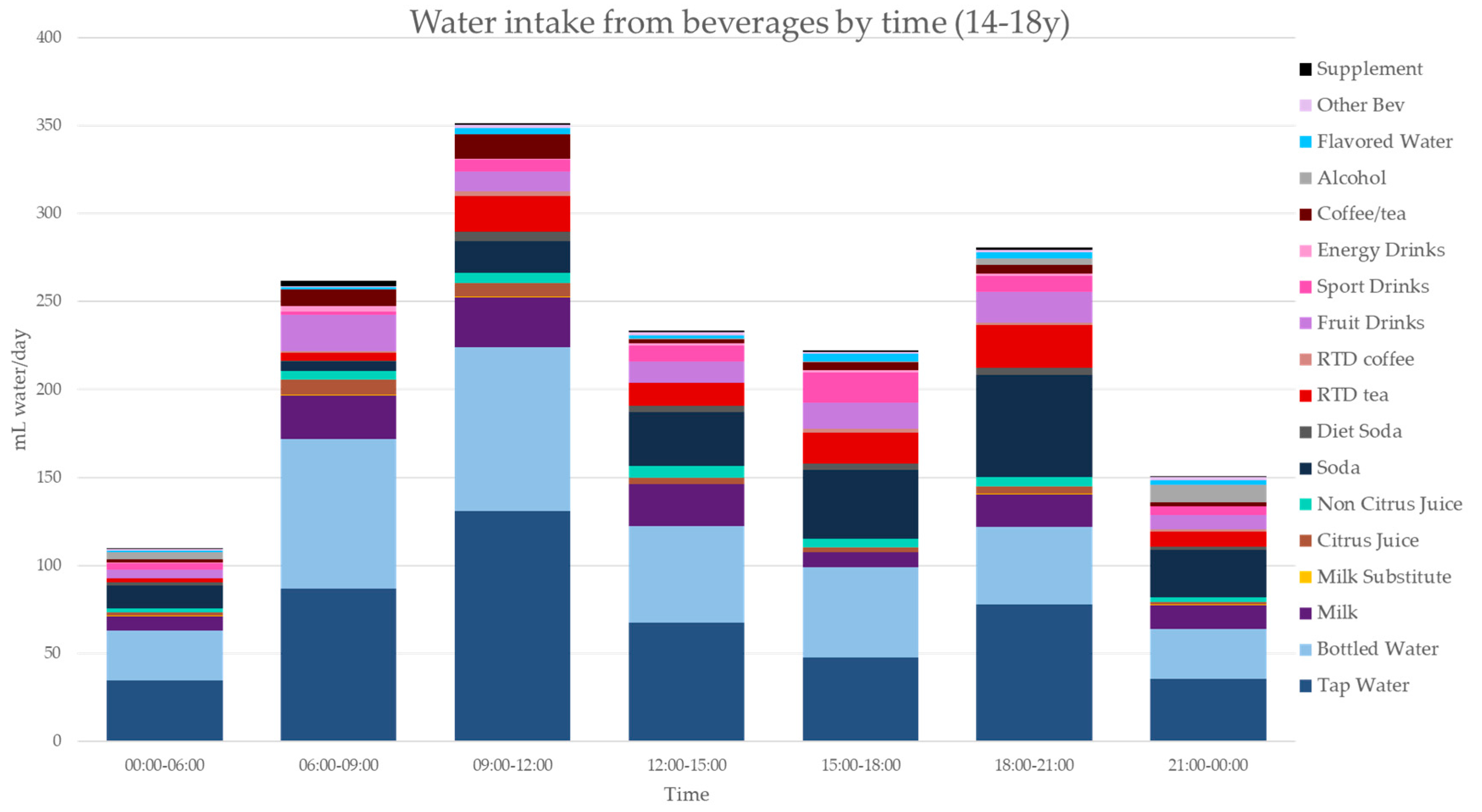
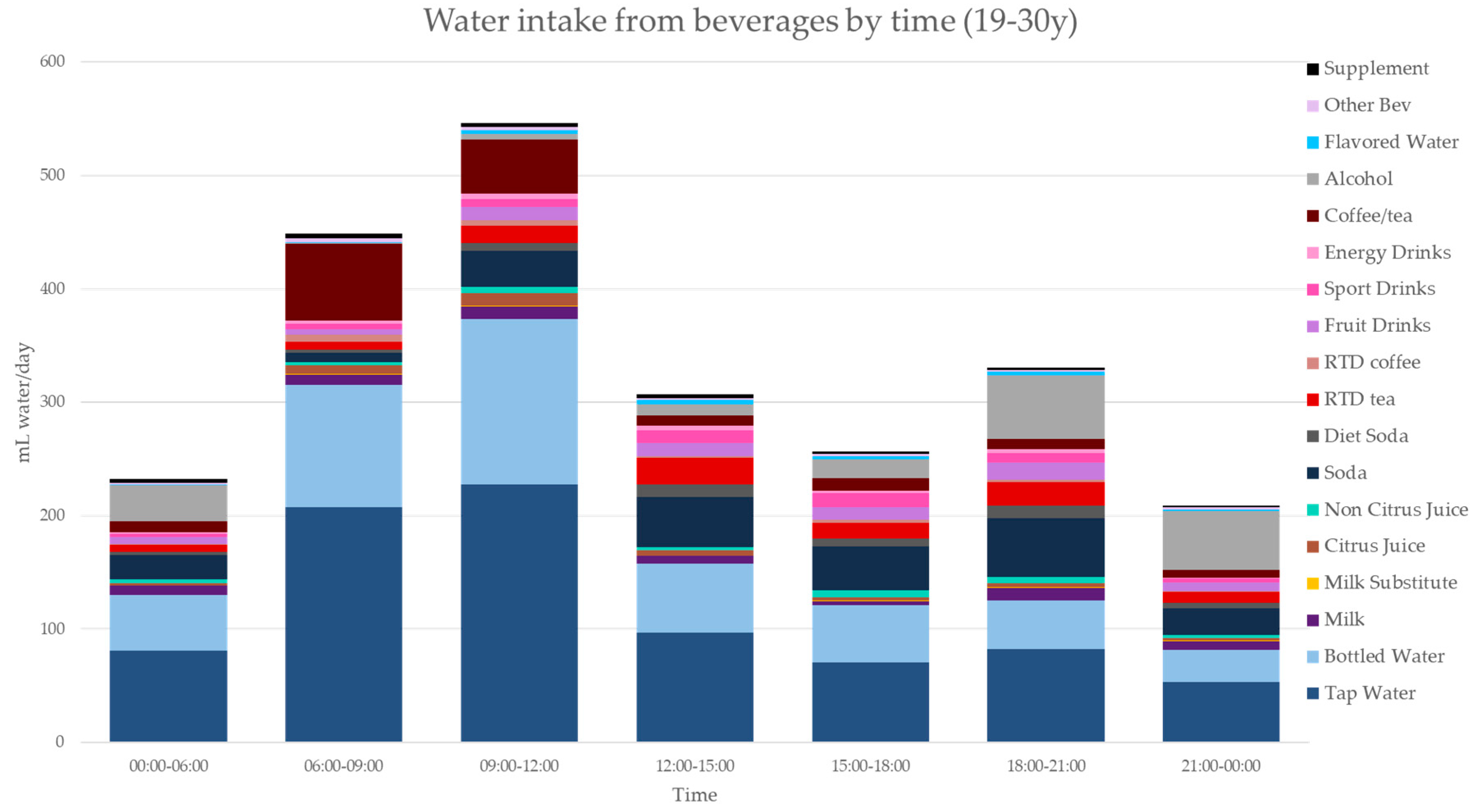
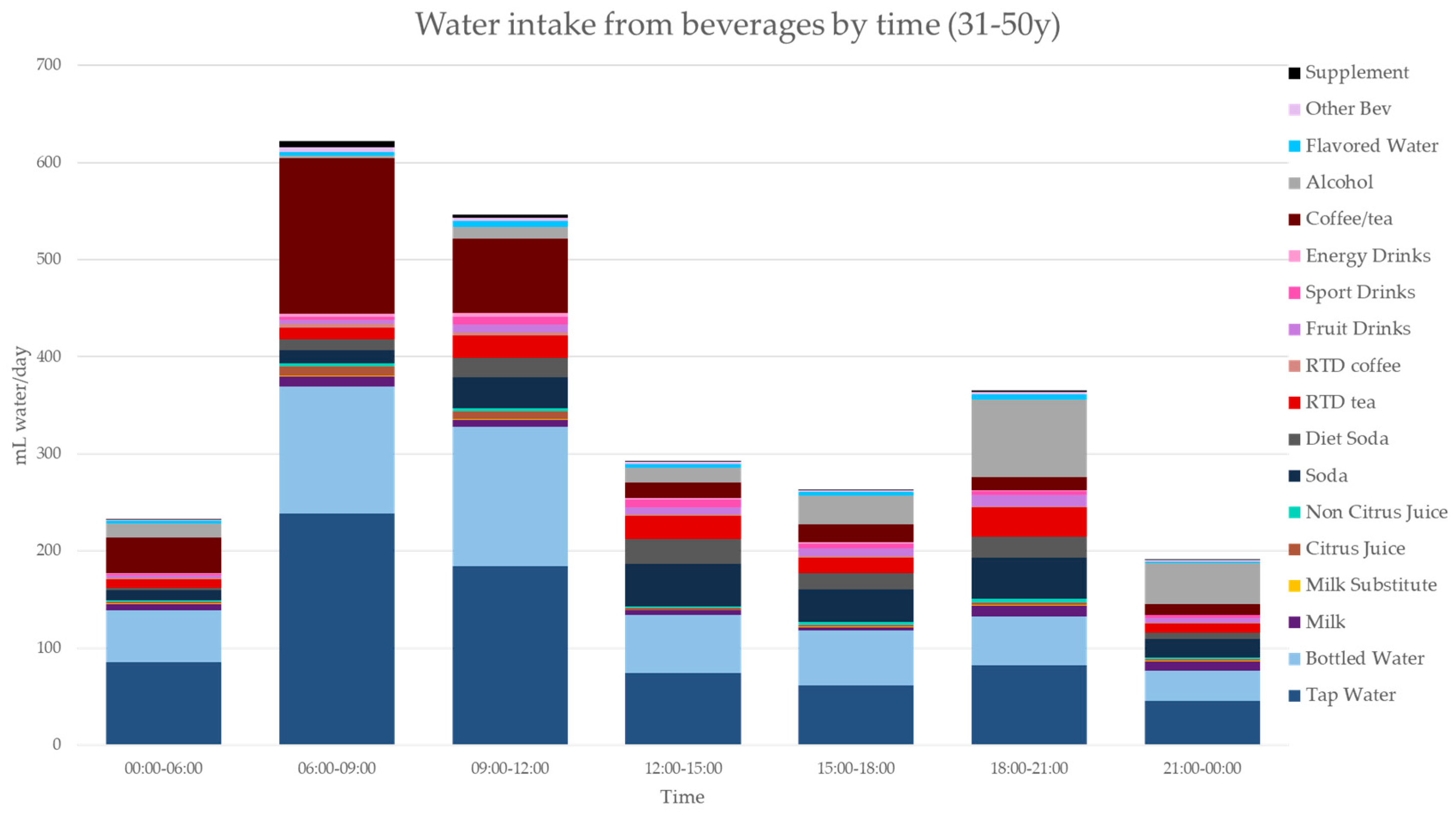
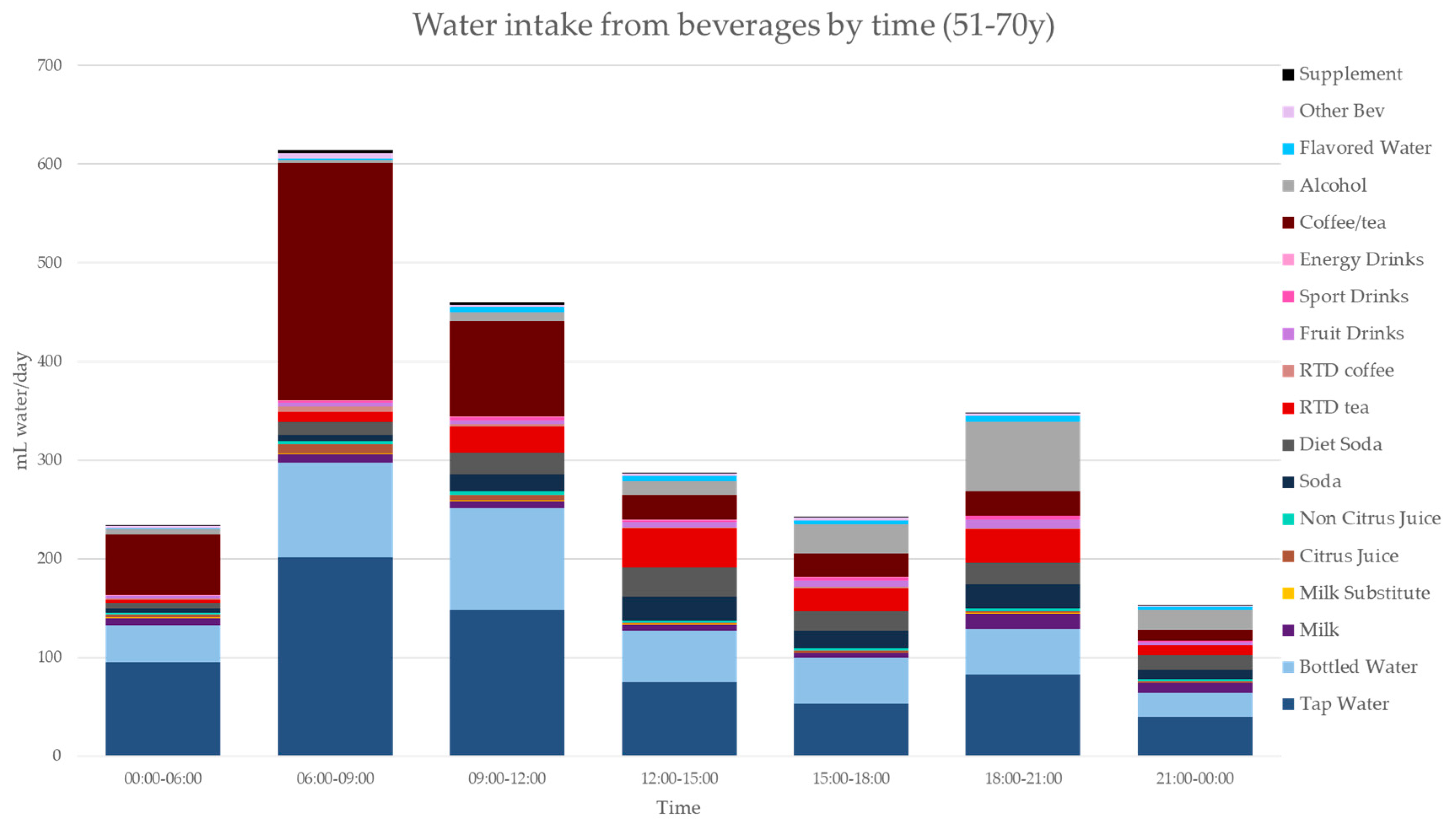
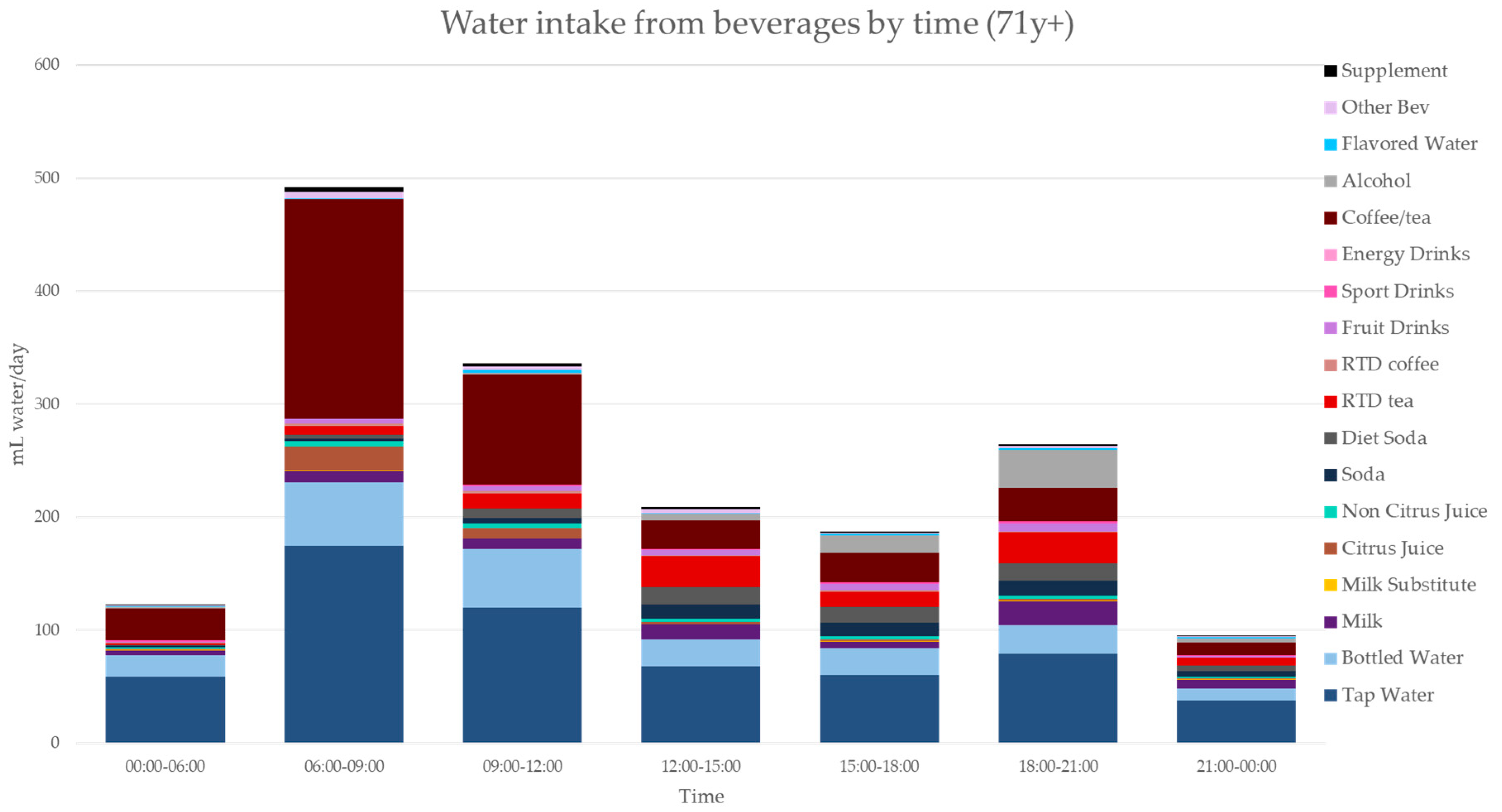
| Water, Beverages, and Foods (mL/d) | Water, Tap and Bottled (mL/d) | Beverages (mL/d) | |||||
|---|---|---|---|---|---|---|---|
| Total mL/d | Water and Beverages mL/d | Food Moisture mL/d | Water, Tap and Bottled | Tap Water | Bottled Water | Beverages | |
| All >4y (N = 22,716) | 2718(27) | 2100(26) | 618(6) | 1066(20) | 661(24) | 404(16) | 1034(17) |
| Sex | |||||||
| Men (N = 11,206) | 2949(36) | 2285(34) | 664(6) | 1071(24) | 676(25) | 395(16) | 1214(24) |
| Women (N = 11,510) | 2495(25) | 1921(24) | 574(7) | 1060(20) | 647(27) | 414(17) | 861(14) |
| p-value for effect | <0.01 | <0.01 | <0.01 | 0.59 | 0.14 | 0.10 | <0.01 |
| Race/ethnicity | |||||||
| NH White (N = 7802) | 2879(31) | 2266(29) | 613(7) | 1109(26) | 781(27) | 328(16) | 1157(23) |
| NH Black (N = 5365) | 2249(36) | 1695(32) | 554(7) | 894(29) | 359(23) | 534(23) | 802(14) |
| Mexican American (N = 4209) | 2487(51) | 1857(48) | 630(10) | 997(36) | 391(21) | 605(26) | 861(19) |
| Other Hispanic (N = 2473) | 2505(38) | 1897(34) | 609(8) | 1041(33) | 497(41) | 544(34) | 856(18) |
| Other (N = 3378) | 2635(38) | 1899(38) | 737(13) | 1092(26) | 658(31) | 434(29) | 807(24) |
| p-value for effect | <0.01 | <<0.01 | <0.01 | <0.01 | <0.01 | <0.01 | <0.01 |
| IPR | |||||||
| <1 (N = 5633) | 2461(49) | 1888(48) | 573(6) | 932(37) | 496(45) | 436(21) | 956(30) |
| 1–1.99(N = 5545) | 2579(38) | 1989(36) | 590(8) | 1003(27) | 555(27) | 448(22) | 986(27) |
| 2–3.49 (N = 4209) | 2692(40) | 2092(39) | 601(9) | 1036(28) | 643(28) | 394(21) | 1055(25) |
| >3.49 (N = 5558) | 2952(38) | 2288(37) | 664(9) | 1181(29) | 821(32) | 360(20) | 1108(19) |
| Missing (N = 1771) | 2616(56) | 1989(52) | 627(13) | 1074(49) | 609(44) | 464(29) | 916(27) |
| p-value for effect | <0.01 | <0.01 | <0.01 | <0.01 | <0.01 | <0.01 | <0.01 |
| Type of meal | |||||||
| Breakfast | 425(5) | 314(4) | 111(1) | 65(2) | 40(2) | 25(1) | 249(4) |
| AM snack | 707(20) | 692(19) | 15(1) | 531(17) | 338(16) | 193(10) | 161(7) |
| Lunch | 428(5) | 256(4) | 172(3) | 93(2) | 54(2) | 39(2) | 163(3) |
| PM snack | 337(7) | 303(7) | 34(1) | 159(4) | 90(4) | 70(2) | 144(5) |
| Dinner | 559(4) | 308(3) | 250(3) | 111(3) | 74(3) | 37(2) | 197(3) |
| Evening snack | 262(4) | 227(4) | 35(1) | 107(3) | 65(3) | 41(2) | 120(3) |
| p-value for effect | <0.01 | <0.01 | <0.01 | <0.01 | <0.01 | <0.01 | <0.01 |
| Time of consumption (h) | |||||||
| 06:00–09:00 | 555(12) | 492(12) | 63(1) | 278(9) | 184(9) | 94(6) | 214(6) |
| 09:00–12:00 | 528(9) | 446(9) | 82(1) | 266(8) | 157(7) | 109(5) | 180(4) |
| 12:00–15:00 | 377(5) | 263(5) | 114(2) | 123(4) | 72(3) | 50(2) | 141(4) |
| 15:00–18:00 | 310(4) | 232(4) | 78(1) | 104(2) | 57(2) | 46(2) | 128(3) |
| 18:00–21:00 | 512(6) | 320(5) | 191(3) | 121(3) | 78(4) | 43(2) | 200(4) |
| 21:00–00:00 | 224(4) | 160(3) | 64(2) | 66(2) | 42(2) | 25(1) | 93(3) |
| 00:00–06:00 | 213(6) | 186(6) | 26(1) | 108(5) | 71(5) | 37(3) | 78(3) |
| p-value for effect | <0.01 | <0.01 | <0.01 | <0.01 | <0.01 | <0.01 | <0.01 |
© 2019 by the authors. Licensee MDPI, Basel, Switzerland. This article is an open access article distributed under the terms and conditions of the Creative Commons Attribution (CC BY) license (http://creativecommons.org/licenses/by/4.0/).
Share and Cite
Vieux, F.; Maillot, M.; Rehm, C.D.; Barrios, P.; Drewnowski, A. The Timing of Water and Beverage Consumption During the Day Among Children and Adults in the United States: Analyses of NHANES 2011–2016 Data. Nutrients 2019, 11, 2707. https://doi.org/10.3390/nu11112707
Vieux F, Maillot M, Rehm CD, Barrios P, Drewnowski A. The Timing of Water and Beverage Consumption During the Day Among Children and Adults in the United States: Analyses of NHANES 2011–2016 Data. Nutrients. 2019; 11(11):2707. https://doi.org/10.3390/nu11112707
Chicago/Turabian StyleVieux, Florent, Matthieu Maillot, Colin D. Rehm, Pamela Barrios, and Adam Drewnowski. 2019. "The Timing of Water and Beverage Consumption During the Day Among Children and Adults in the United States: Analyses of NHANES 2011–2016 Data" Nutrients 11, no. 11: 2707. https://doi.org/10.3390/nu11112707
APA StyleVieux, F., Maillot, M., Rehm, C. D., Barrios, P., & Drewnowski, A. (2019). The Timing of Water and Beverage Consumption During the Day Among Children and Adults in the United States: Analyses of NHANES 2011–2016 Data. Nutrients, 11(11), 2707. https://doi.org/10.3390/nu11112707






